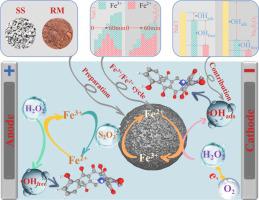当前位置:
X-MOL 学术
›
Sep. Purif. Technol.
›
论文详情
Our official English website, www.x-mol.net, welcomes your feedback! (Note: you will need to create a separate account there.)
Red mud/steel slag three-dimensional electrochemical system for the removal of organic pollutant with Na2S2O3 as electrolyte: Contribution of •OHads
Separation and Purification Technology ( IF 8.1 ) Pub Date : 2024-07-10 , DOI: 10.1016/j.seppur.2024.128774 Yi Han , Mengxin Guo , Ting Shi , Zhipeng Wang , Yi Wang , Zhibing Xu , Dejin Wang , Hongcheng Gao , Zheng Peng , Haobo Hou
Separation and Purification Technology ( IF 8.1 ) Pub Date : 2024-07-10 , DOI: 10.1016/j.seppur.2024.128774 Yi Han , Mengxin Guo , Ting Shi , Zhipeng Wang , Yi Wang , Zhibing Xu , Dejin Wang , Hongcheng Gao , Zheng Peng , Haobo Hou

|
The dynamic changes in the iron redox cycle (Fe/Fe) played a crucial role in the electro-Fenton degradation of organic pollutants. The synthesis of composite particle electrodes RMSSx:y from a mixture of steel slag (SS) and red mud (RM) was applied in a three-dimensional electrochemical system for the remediation of hydrochloric tetracycline (TCH) in wastewater, utilizing NaSO as an electrolyte. Further, some investigations were conducted to determine the effects of RM/SS, electrolyte, particle electrode dosage, cell voltage, and pH on TCH degradation efficiency. Under optimal conditions such as 8 g/L RMSS particle electrodes, a cell voltage of 4 V, an initial pH of 3, and 6 mM NaSO electrolyte, the degradation rate of TCH in wastewater was 98.3 %. Meanwhile, its total organic carbon (TOC) was reduced by 88 % within 60 min. Cyclic experiments with consistently high degradation efficiency demonstrated the stability of the particle electrode RMSS. The practical applicability of RMSS was further confirmed through its successful treatment of various industrial wastewaters, including dyeing (DW), chemical (CW), and pharmaceutical (PW) effluents, achieving chemical oxygen demand (COD) removal rates of 67.8 %, 67.6 %, and 65.0 % respectively. The enhancement of TCH degradation through the utilization of NaSO as the electrolyte was primarily attributed to the complexation and reduction effects exerted by SO ions. These effects prevented the leaching and precipitation of iron ions, facilitated the reduction of Fe (III), and consequently enabled •OH to play a dominant role in the degradation process. These findings demonstrated the potential of RMSS in efficiently degrading emerging contaminants, thereby offering an innovative approach for utilizing SS and RM as functional materials in electro-Fenton processes.
中文翻译:

以Na2S2O3为电解液的赤泥/钢渣三维电化学体系去除有机污染物:·OHads的贡献
铁氧化还原循环(Fe/Fe)的动态变化在有机污染物的电芬顿降解中发挥着至关重要的作用。将钢渣(SS)和赤泥(RM)的混合物合成复合颗粒电极RMSSx:y,应用于三维电化学系统中,以NaSO作为电解质修复废水中的盐酸四环素(TCH) 。此外,还进行了一些研究以确定 RM/SS、电解质、颗粒电极剂量、电池电压和 pH 对 TCH 降解效率的影响。在8 g/L RMSS颗粒电极、电池电压4 V、初始pH 3、6 mM NaSO电解液等最佳条件下,废水中TCH的降解率为98.3%。同时,其总有机碳 (TOC) 在 60 分钟内减少了 88%。持续高降解效率的循环实验证明了颗粒电极 RMSS 的稳定性。 RMSS 成功处理各种工业废水,包括印染 (DW)、化工 (CW) 和制药 (PW) 废水,进一步证实了 RMSS 的实际适用性,实现了 67.8%、67.6% 的化学需氧量 (COD) 去除率、 和 65.0% 分别。利用Na2SO4作为电解质增强TCH降解主要归因于SO2离子产生的络合和还原作用。这些作用阻止了铁离子的浸出和沉淀,促进了Fe(III)的还原,从而使·OH在降解过程中发挥了主导作用。 这些发现证明了 RMSS 在有效降解新兴污染物方面的潜力,从而提供了一种在电芬顿工艺中利用 SS 和 RM 作为功能材料的创新方法。
更新日期:2024-07-10
中文翻译:

以Na2S2O3为电解液的赤泥/钢渣三维电化学体系去除有机污染物:·OHads的贡献
铁氧化还原循环(Fe/Fe)的动态变化在有机污染物的电芬顿降解中发挥着至关重要的作用。将钢渣(SS)和赤泥(RM)的混合物合成复合颗粒电极RMSSx:y,应用于三维电化学系统中,以NaSO作为电解质修复废水中的盐酸四环素(TCH) 。此外,还进行了一些研究以确定 RM/SS、电解质、颗粒电极剂量、电池电压和 pH 对 TCH 降解效率的影响。在8 g/L RMSS颗粒电极、电池电压4 V、初始pH 3、6 mM NaSO电解液等最佳条件下,废水中TCH的降解率为98.3%。同时,其总有机碳 (TOC) 在 60 分钟内减少了 88%。持续高降解效率的循环实验证明了颗粒电极 RMSS 的稳定性。 RMSS 成功处理各种工业废水,包括印染 (DW)、化工 (CW) 和制药 (PW) 废水,进一步证实了 RMSS 的实际适用性,实现了 67.8%、67.6% 的化学需氧量 (COD) 去除率、 和 65.0% 分别。利用Na2SO4作为电解质增强TCH降解主要归因于SO2离子产生的络合和还原作用。这些作用阻止了铁离子的浸出和沉淀,促进了Fe(III)的还原,从而使·OH在降解过程中发挥了主导作用。 这些发现证明了 RMSS 在有效降解新兴污染物方面的潜力,从而提供了一种在电芬顿工艺中利用 SS 和 RM 作为功能材料的创新方法。
















































 京公网安备 11010802027423号
京公网安备 11010802027423号